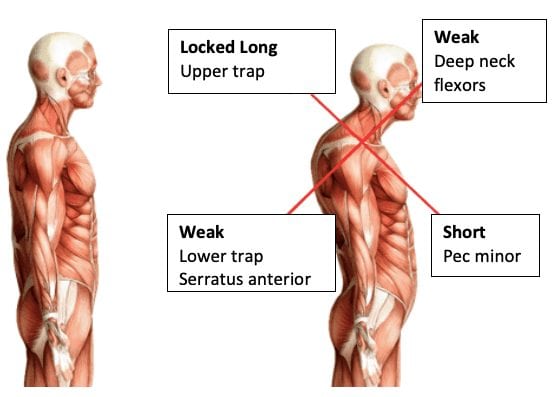
The word yoga comes from the root ‘yuj’ which means ‘to yoke’ or ‘to unite’. Each yogi has a unique perspective on what exactly yoga helps to unite, but there is a general consensus that practicing yoga connects the body, breath and mind through asanas (postures), pranayama (breathing), and dhyana (meditation). It is an ancient practice that has recently experienced a surge of popularity in the West and as a result has been shrouded in misconceptions. The misconception we will seek to dismantle in this blog is: ‘yoga is all about stretching.”
First, let’s discuss stretching in more detail. By definition, stretching means lengthening a muscle that is short. Stretching non-contractile tissue, such as a tendon or ligament, is not beneficial. We stretch muscles that are short so that they can return to their normal resting length, which enables them to work properly. As an example, the pectoralis minor muscle is one that is commonly short as a result of prolonged improper posture while sitting, driving, etc. where the head and shoulders are positioned forward. When this muscle truly shortens, it will benefit from lengthening. It is important to note that not all muscles shorten due to poor posture. In the case of the upper trapezius muscle, it is often in a state of being ‘locked long’ where the muscle is over-stretched and dysfunctional. In this case, the muscle will NOT benefit from stretching as that will only make things worse. The upper trapezius benefits from strengthening to return it to its normal resting length.

In each yoga pose, there is a strengthening component and a stretching component. By looking at the photo below, it is evident that typically the muscles on one side of the body lengthen while the muscles on the opposite side contract. Case in point, yoga poses do not focus solely on stretching. In a well-balanced yoga class, there should be a good mix of poses that facilitate stretching and contracting of all major muscle groups, which we know is beneficial to our musculoskeletal system, but a lesser known benefit involves our nervous system.

The autonomic nervous system is one part of the peripheral nervous system, which includes everything outside of the brain and spinal cord, that involuntarily controls our internal organs, and regulates heart rate, blood pressure, breathing, etc. The autonomic nervous system has 2 divisions: sympathetic and parasympathetic. The sympathetic nervous system is commonly referred to as the ‘fight or flight’ system as it functions to get the body ready to act quickly in dangerous or stressful situations. This system pumps blood away from the internal organs to the muscles (so that if needed we could fight or flee), increases heart and breathing rates, and releases a quick shot of insulin into the blood for energy. The sympathetic nervous system is only meant to be active for short amounts of time; however, research has shown that more and more people live in a chronic state of sympathetic activation due to stress. Manifestations of the phenomenon might include impaired digestion, elevated blood glucose levels, and impaired immune system activity. In addition, it can result in increased sensitivity of the entire nervous system which manifests as ‘nervy’ symptoms in the arms, hands, legs or feet. Nerves do not communicate sensitivity via a typical pain signal; when they are irritated, it may like feel like numbness, tingling, burning, stinging, buzzing, etc. These ‘nervy’ symptoms can be a result of an overactive sympathetic nervous system. Conversely, the parasympathetic nervous system, also referred to as the ‘rest and digest’ system, is active whenever the sympathetic system is not and works to maintain homeostasis in the body. This system directs blood to the digestive system, maintains normal breathing and heart rates, and is integral to healing. As previously stated, many of us spend too much time in ‘fight or flight’ mode, but the good news is that mindful practices such as yoga and meditation are effective ways to decrease the activity of this system and promote rest and relaxation. By both lengthening and contracting major muscle groups, the nerves that branch off the spinal cord and innervate muscles are nourished and revitalized. In addition, the general calming environment of a yoga class coupled with gentle movement works to activate the ‘rest and digest’ system and maintain us in a state of healing. Lastly, recent studies have shown that meditative practices which emphasize becoming aware of the breath can decrease the activity of the sympathetic nervous system.

In summary, yoga is a practice which utilizes poses and breathing techniques to unite mind and body in order to promote healing and restoration. Is stretching a part of that? Yes. Is stretching the only part of that? Certainly not.
**”Catherine is a third year DPT student at Texas State University whose clinical rotations have included outpatient orthopedics, geriatrics, spinal cord injury rehabilitation, and lastly neuromuscular rehab at CHARM. She looks forward to staying in Austin after graduation this May and continuing to enjoy the amazing food, live music, and outdoor activities the city has to offer.”



